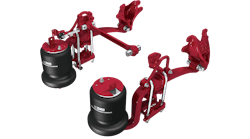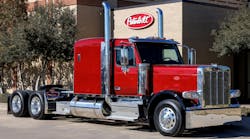Diesel prices have fallen well below the historic highs of 2008, but fuel conservation remains a critical concern for tank truck fleets. Fuel must be considered when fleet managers look for ways to trim operating costs.
Richard Moskowitz, vice-president and regulatory affairs counsel for the American Trucking Associations, discussed the causes of the diesel price run up in 2008 and the fuel-price outlook for the future during the National Tank Truck Carriers 2008 Cargo Tank Maintenance Seminar in Louisville, Kentucky. He also reviewed fuel conservation strategies.
US diesel prices soared to a record average of $4.76 a gallon in 2008, and the trucking industry consumed approximately 39.1 billion gallons of diesel at an estimated total cost of $156.8 billion. Consumption in 2007 was roughly the same, but the total cost was just $112.6 billion.
Clearly, the higher fuel costs in 2008 had a significant impact on trucking companies, according to Moskowitz. Fleets were able to cover most of the cost increases with fuel surcharges, but there were times when the surcharges couldn't keep pace with the rising prices.
Those fuel price increases were driven by a variety of factors, both domestic and international. Crude oil — the diesel feedstock — is a global commodity priced in US dollars. The value of the dollar and oil/diesel prices is highly correlated, according to Moskowitz.
Largest consumer
Currently, the United States is the world's largest crude oil consumer, but that is changing. Demand for crude oil is surging in China and India as their economies develop. Demand also is growing in other countries, and all of that is helping to drive oil prices.
Supply limitations also affect price. Moskowitz cited what he calls a “Wall of Worry” on the supply side. Factors include a security risk premium because so much of the world's crude oil supply comes from regions that are politically unstable. A number of countries, such as Venezuela, have tried to use oil as a weapon. Hurricanes and other weather events add to the price of oil.
Despite the challenges, things can be done to rein in diesel prices. The federal government could grant more access to areas of the United States that currently are off limits to drilling.
“The current policy of the US government, particularly Congress, is don't drill; pay more,” Moskowitz said. “We have more oil resources than Saudi Arabia, but they are off limits. The Alaska National Wildlife Refuge contains 10 billion barrels of oil. Another 18 billion barrels of oil are offshore in the outer continental shelf. The oil shale in the Green River Basin may hold up to 800 billion barrels of oil.”
Federal action
Federal action is needed to make the oil trading process more orderly, Moskowitz said. Greater transparency is needed in the market, and excessive speculation by investors must be eliminated.
The federal government also can help the trucking industry to conserve fuel and minimize the impact of higher oil prices. Moskowitz urged Congress to pass legislation that would mandate speed reduction, incentivize idling reduction, eliminate traffic congestion, develop more aggressive fuel economy standards, expand the Environmental Protection Agency's SmartWay program, and promote the development of more productive trucks.
Truck fleets also can do a lot to rein in fuel costs. Fleets need to take a closer look at alternative fuel options, particularly biodiesel. There are times when the biodiesel price is lower than petroleum-based diesel.
Fleets also need to develop a company-wide passion for reducing fuel consumption, and it must be a top-down commitment. While a company-wide commitment is critical, drivers probably play the biggest roll in the fuel conservation effort.
“Most of the fuel economy factors are under the control of the driver,” Moskowitz said. “Drivers can account for a 35% differential in fuel economy. For instance, a carrier's best drivers should be able to achieve up to seven miles per gallon. The worst drivers are going to get around five miles per gallon. Everyone has heard how much it costs to lose a driver; but how much does it cost to retain drivers with poor fuel-economy habits?”
Driver training
Drivers must be taught from the moment they join the company to conduct thorough pre-trip inspections. In addition to looking for safety-related problems, drivers can spot maintenance issues such as worn suspensions, irregular tire wear, and air intake restrictions that impact fuel economy.
Uneven tire wear can be an indication of an alignment problem, which will result in increased drag. There is greater scrub of the tires against the road surface, and, potentially, increased aerodynamic drag when the tractor and trailer are not tracking parallel to the direction of travel.
Tire inflation is another key factor, and drivers and mechanics always should use a calibrated pressure gauge. Improper inflation pressure can reduce fuel economy by 2% to 3%. “Inflation pressure has the most drastic effect on tire wear of all the factors involved,” Moskowitz said.
Under inflation is worse than over inflation. In addition to uneven tire wear, under inflation generates heat that impacts tire life.
Speed penalty
Speed is another factor impacting fuel economy. Every one mile per hour speed increase brings a penalty of about a tenth mile per gallon. For instance, a truck that gets six miles per gallon at 65 miles per hour will see efficiency drop to around five miles per gallon at 75 miles per hour.
ATA has recommended speed limiters for heavy-duty trucks. If fleets set their trucks to run 65 miles per hour, the industry could save 2.8 billion gallons of diesel and reduce CO2 emissions by 31.5 million tons over 10 years. That would be a significant savings.
Cruise control can help drivers maintain a constant speed and improve fuel economy by up to 6%, according to Moskowitz. He encouraged drivers to coast in gear whenever possible. Coasting in gear consumes no fuel and helps limit engine rpm. However, coasting out of gear is unsafe.
“Drivers need to maintain truck momentum in traffic and avoid rapid acceleration, aggressive driving, and sudden lane changes,” Moskowitz said. “Use progressive shifting and gentle acceleration to get to the higher gears. Avoid full throttle to get over the top of a grade.”
Progressive shifting keeps the engine rpm as low as possible. Drivers only should increase engine rpm by the amount needed to get into the next higher gear and still pull the load, and they should stay in the highest gear as long as possible.
The number of stops should be limited as much as is practical. Frequent starting and stopping wastes fuel. Drivers should combine stops (refueling, meal breaks, restroom breaks, and customer deliveries/pickups) as much as possible. Every stop costs .2 to .3 gallon of fuel, and that includes getting back up to speed after the stop.
Idle reduction
Drivers and fleets must work together to reduce engine idling, which consumes fuel at a rate of about 8/10 gallon per hour. Truck idling industry wide consumes 1.1 billion gallons of diesel annually and produces 13.3 million tons of CO2, according to Moskowitz.
Drivers can reduce idling time by using driver lounges and breakrooms whenever possible. They need to cool down or warm up the cab interior prior to taking a break, and they need to change the traditional engine warm-up/cool-down habit.
Drivers need to plan more wisely when selecting a place to park and sleep. During the winter, they need to sleep at lower elevations and preheat the bunk. Winter sleep preparation include wearing socks, stocking cap, and sweat suit to stay warm with the engine shut down. Summer sleep preparations include using window screens and shades.
Fleet idle reduction strategies include specifying tractors with auxiliary power units, bunk heaters, and deep-cycle batteries. Fleet managers also need to track the amount of idling in their operation. Studies show that idling accounts for 30% to 50% of over-the-road time.
Clearly, fleets have plenty of opportunities to conserve fuel and reduce operating costs. Idle reduction is just one of the many places to start.








